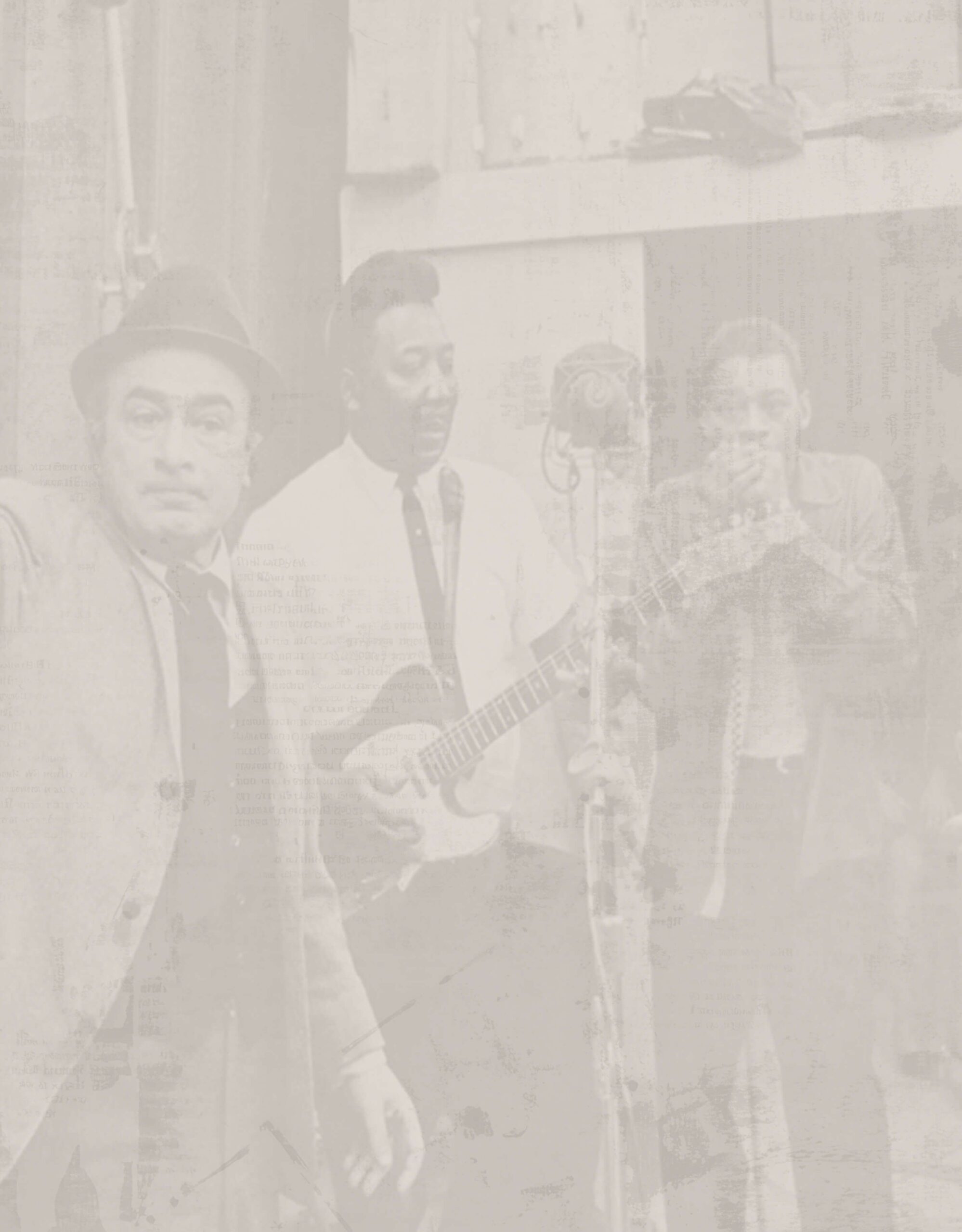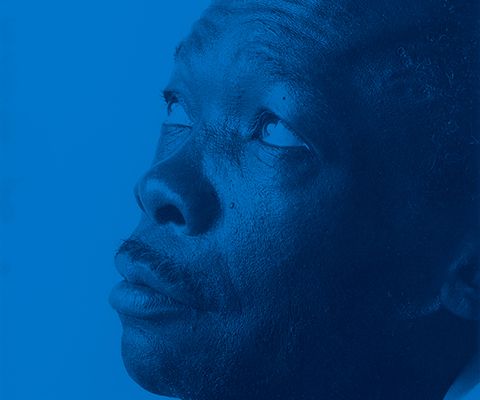John Lee Hooker
John Lee Hooker
“I absorbed [John Lee Hooker] more than anybody…it was part of a whole framework of this type of music – blues and gospel. So, to me, it was something spiritual.” -Van Morrison
He was born and raised in the Mississippi Delta, but singer/guitarist John Lee Hooker was something of an omnipresent figure as electric blues began to come into its own. His impressive voice, amplified guitar and gripping compositions (including the standards “Boogie Chillen,” and “Boom Boom”) were heard on at least 20 different labels under multiple aliases throughout the 1950s - including a stint on Chess, which helped bring his approach to the genre into sharper focus.
Born between 1912 and 1917 near Clarksdale, Mississippi, Hooker was one of seven children born to a sharecropper and Baptist preacher who initially banned non-religious music from the house. When his parents divorced and stepfather William Moore (an amateur blues singer himself) entered the picture, he encouraged his stepson’s musical diversity. Armed with his trusty guitar, Hooker left home in his teens and made a living as an itinerant worker and musician, living in Memphis and eventually Detroit, where he worked in the Ford factory by day and played club gigs by night.
Hooker’s style combined the amplification of Chicago-style blues with a simple lyrical delivery and rhythmic, groove-forward playing. A Detroit demo with producer Bernie Besman made its way to Los Angeles’ Modern Records; they released his “Boogie Chillen” in 1948, which became a No. 1 hit on the R&B charts and one of the genre’s bestselling releases of the following year. Hooker kept listeners and eventual collectors on their toes by releasing songs for various labels, often under different names like “Texas Slim,” “Delta John,” “Johnny Lee,” “The Boogie Man” and even “Little Pork Chops.” His Chess sessions, cut in 1951 and 1952, were variously released under the name John Lee Booker as well as his own name; though he never learned to read, all the songs he recorded for Chess, including “Walkin’ the Boogie,” “Ramblin’ by Myself” and “It’s My Own Fault,” were all his own creations. (Many of the sides were released in 1959 on House of the Blues, one of his first long-playing records.)
By that time, Hooker had settled into a groove as a recording artist for the Vee-Jay label, where he’d release hits like the R&B No. 1 “I’m in the Mood” and arguably his signature song “Boom Boom.” He’d also popularize other blues standards, including “One Bourbon, One Scotch, One Beer” and “Crawling King Snake,” the latter a favorite of The Doors, who covered it on their L.A. Woman album in 1970. A stint on the American Folk Blues Festival tours of Europe, which propelled other Chess signees to international acclaim, boosted his profile overseas, and he’d become an in-demand collaborator for much of the rest of his life. He recorded with Canned Heat, Steve Miller, Elvin Bishop, Van Morrison, Carlos Santana and Bonnie Raitt - the latter of whom inducted him into the Rock and Roll Hall of Fame in 1991. He was also honored as an inaugural member of the Blues Hall of Fame in 1980, received a star on the Hollywood Walk of Fame in 1997 and earned a Grammy Lifetime Achievement Award in 2000, one year before his passing.
He was born and raised in the Mississippi Delta, but singer/guitarist John Lee Hooker was something of an omnipresent figure as electric blues began to come into its own. His impressive voice, amplified guitar and gripping compositions (including the standards “Boogie Chillen,” and “Boom Boom”) were heard on at least 20 different labels under multiple aliases throughout the 1950s - including a stint on Chess, which helped bring his approach to the genre into sharper focus.
Born between 1912 and 1917 near Clarksdale, Mississippi, Hooker was one of seven children born to a sharecropper and Baptist preacher who initially banned non-religious music from the house. When his parents divorced and stepfather William Moore (an amateur blues singer himself) entered the picture, he encouraged his stepson’s musical diversity. Armed with his trusty guitar, Hooker left home in his teens and made a living as an itinerant worker and musician, living in Memphis and eventually Detroit, where he worked in the Ford factory by day and played club gigs by night.
Hooker’s style combined the amplification of Chicago-style blues with a simple lyrical delivery and rhythmic, groove-forward playing. A Detroit demo with producer Bernie Besman made its way to Los Angeles’ Modern Records; they released his “Boogie Chillen” in 1948, which became a No. 1 hit on the R&B charts and one of the genre’s bestselling releases of the following year. Hooker kept listeners and eventual collectors on their toes by releasing songs for various labels, often under different names like “Texas Slim,” “Delta John,” “Johnny Lee,” “The Boogie Man” and even “Little Pork Chops.” His Chess sessions, cut in 1951 and 1952, were variously released under the name John Lee Booker as well as his own name; though he never learned to read, all the songs he recorded for Chess, including “Walkin’ the Boogie,” “Ramblin’ by Myself” and “It’s My Own Fault,” were all his own creations. (Many of the sides were released in 1959 on House of the Blues, one of his first long-playing records.)
By that time, Hooker had settled into a groove as a recording artist for the Vee-Jay label, where he’d release hits like the R&B No. 1 “I’m in the Mood” and arguably his signature song “Boom Boom.” He’d also popularize other blues standards, including “One Bourbon, One Scotch, One Beer” and “Crawling King Snake,” the latter a favorite of The Doors, who covered it on their L.A. Woman album in 1970. A stint on the American Folk Blues Festival tours of Europe, which propelled other Chess signees to international acclaim, boosted his profile overseas, and he’d become an in-demand collaborator for much of the rest of his life. He recorded with Canned Heat, Steve Miller, Elvin Bishop, Van Morrison, Carlos Santana and Bonnie Raitt - the latter of whom inducted him into the Rock and Roll Hall of Fame in 1991. He was also honored as an inaugural member of the Blues Hall of Fame in 1980, received a star on the Hollywood Walk of Fame in 1997 and earned a Grammy Lifetime Achievement Award in 2000, one year before his passing.


